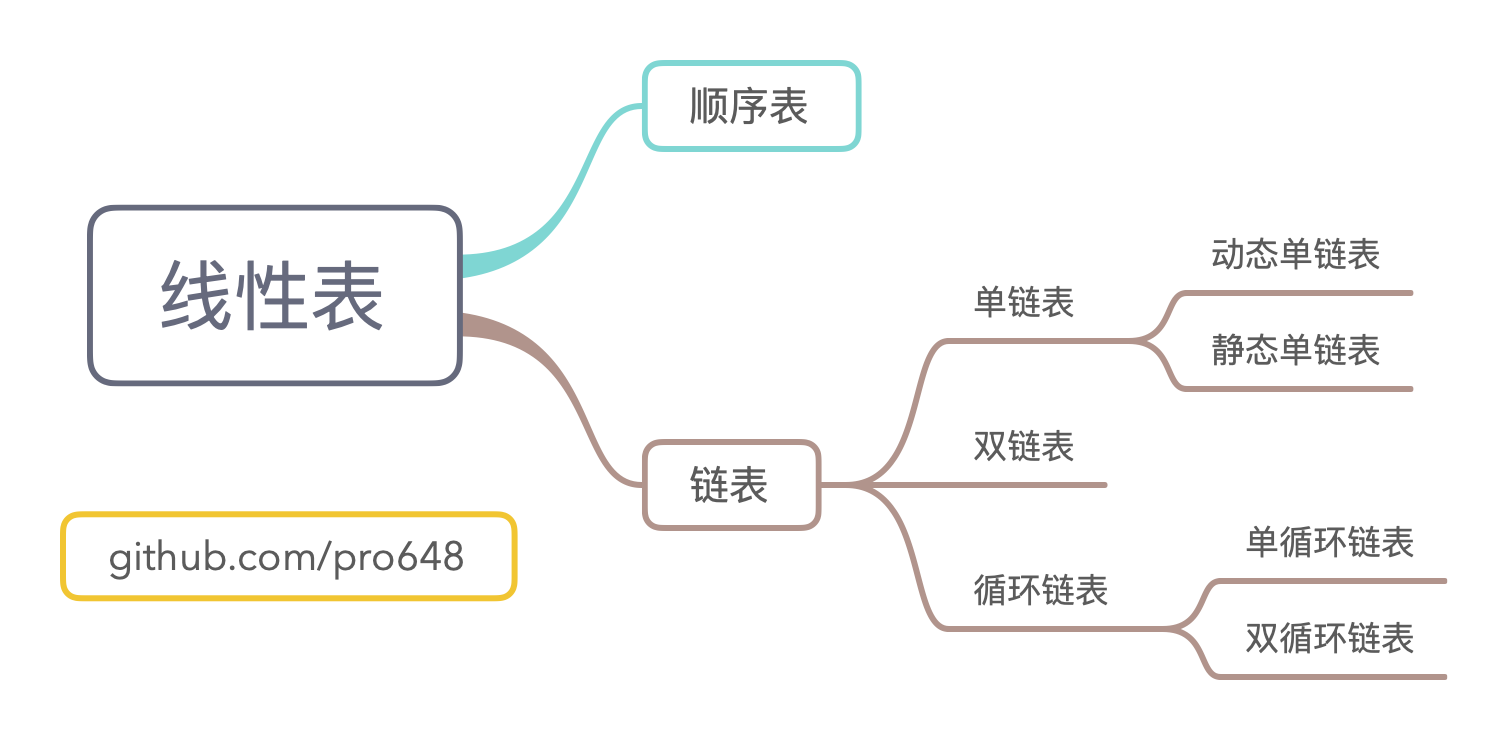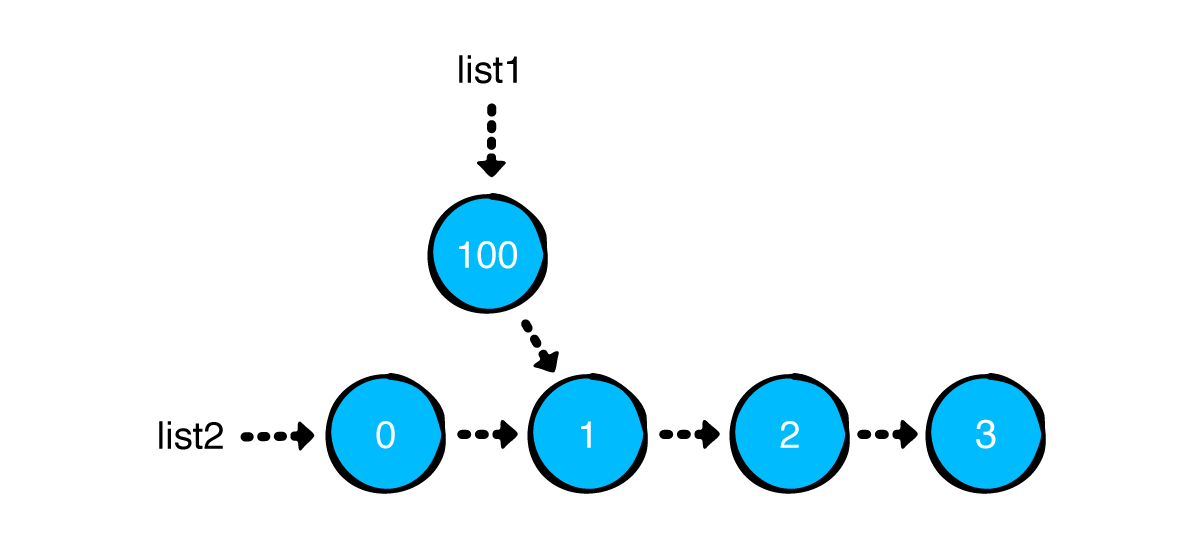链表 LinkedList
链表(Linked list)是一种常见的基础数据结构,是一种线性表,但并不会按线性的顺序存储数据,而是在一个节点里存储下一个节点的指针。由于无需顺序存储,链表在插入时复杂度可以达到O(1),比顺序表快很多,但是查找一个节点或访问特定编号的节点需O(n)的时间,而顺序表相应的时间复杂度分别是O(logn)和O(1)。
与需在内存中连续存储的线性表(如数组)相比,链表有以下优势:
- 对链表头节点进行添加、移除操作,所需时间为常数。
- 性能稳定。

如上图所示,链表是一个节点链。节点有以下两个用途:
- 保存值。
- 保存下一个节点的指针。
这篇文章将介绍链表的基本特征,手动实现一个链表及其常见操作,并实现 Swift 中的写时拷贝(copy-on-write)技术。最后,还会介绍几道常见的链表算法题。

线性表(linear list)可以分为顺序表和链表。
顺序表是在计算机内存中以数组的形式保存的线性表,是指用一组地址连续的存储单元依次存储数据元素的线性结构。顺序表和链表有以下几点区别:
- 空间开辟方式:顺序表在存储数据之前开辟足够空间,后期无法改变大小(动态数组除外),链表一次只开辟存储一个节点的内存空间。一次开辟大量空间比多次开辟小量空间性能好。
- 空间利用率:链表每次申请一个节点的空间,且位置随机。这种申请存储空间的方式会有很多空间碎片,一定程度上造成了空间浪费。此外,链表每个节点至少需携带一个指针,增加了空间占用。因此,顺序表空间利用率比链表高。
- 时间复杂度:顺序表可以使用下标直接访问元素,它的时间复杂度为
O(1),链表需从头开始,依次遍历,时间复杂度为O(n)。顺序表中插入、删除、移动元素,可能涉及大量元素的整体移动,时间复杂度为O(n),链表插入、删除、移动元素,只需改变指针指向,时间复杂度为O(1)。
链表可以分为以下几类:
-
单向链表(singly linked list):是链表中最简单的,它包含两个域,一个信息域和一个指针域,指针指向链表中的下一个节点,最后一个节点的指针指向一个空值。

- 静态单向链表:用数组描述的单向链表,称为静态单向链表。它的内存地址是连续的,需预先分配大小。
- 动态单向链表:用申请内存的函数动态申请内存,链表长度没有限制,节点内存地址不是连续的,需通过指针来顺序访问。
-
双向链表(doubly linked list):每个节点有两个连接,一个指向前一节点,另一个指向后一节点。首、尾节点对应的前、后连接指向空值或空列表。

-
循环链表(circular linked list):首节点、尾节点连接在一起。循环链表第一个节点之前就是最后一个节点;反之亦然。

- 单向循环链表:它的最后一个节点指针不是 NULL,而改为指向头节点,从而整个链表形成一个环。
- 双向循环链表:由单向循环链表可以推断出双向循环链表,它的头节点还会指向尾节点。
这篇文章只介绍单向链表。
创建 Node.swift 文件,添加以下代码:
public class Node<Value> {
public var value: Value
public var next: Node?
public init(value: Value, next: Node? = nil) {
self.value = value
self.next = next
}
}
extension Node: CustomStringConvertible {
public var description: String {
guard let next = next else { return "\(value)" }
return "\(value) -> " + String(describing: next) + " "
}
}
在 playground page 添加以下代码:
example(of: "creating and linking nodes") {
let node1 = Node(value: 1)
let node2 = Node(value: 2)
let node3 = Node(value: 3)
node1.next = node2
node2.next = node3
print(node1)
}
上述代码创建了三个 node,并链接起来。

控制台输出如下:
--- Example of creating and linking nodes ---
1 -> 2 -> 3
使用上述方式创建链表会很麻烦,后续会通过 LinkedList 管理 node。
创建 LinkedList.swift 文件,并添加以下代码:
public struct LinkedList<Value> {
public var head: Node<Value>?
public var tail: Node<Value>?
public init() { }
public var isEmpty: Bool {
head == nil
}
}
extension LinkedList: CustomStringConvertible {
public var description: String {
guard let head = head else { return "Empty list" }
return String(describing: head)
}
}
Linked list 有头、尾概念,指向链表的第一个和最后一个节点。

后续会逐步为链表提供管理 node 的接口。先提供添加节点的功能。有以下三种添加节点的方式:
- push:向链表头部添加节点。
- append:向链表尾部添加节点。
- insert(after:):向指定节点后添加节点。
下面会依次实现上述接口,并分析其性能。
向链表头部添加节点被称为 push 操作。它的实现非常简单:
public mutating func push(_ value: Value) {
head = Node(value: value, next: head)
if tail == nil {
tail = head
}
}
当向空链表 push 时,新添加的 node 既是 head,也是 tail。
在 playground page 添加以下代码:
example(of: "push") {
var list = LinkedList<Int>()
list.push(3)
list.push(2)
list.push(1)
print(list)
}
控制台输出如下:
--- Example of push ---
1 -> 2 -> 3
append 是向链表尾部添加节点。
在 LinkedList.swift 文件的push(value:)方法下面添加以下代码:
public mutating func append(_ value: Value) {
guard !isEmpty else {
push(value)
return
}
tail!.next = Node(value: value)
tail = tail!.next
}
当链表为空时,直接使用 push 添加,这样可以自动处理 head、tail;不为空时,在尾部添加一个 node,并将其设置为 tail。
在 playground page 添加以下代码:
example(of: "append") {
var list = LinkedList<Int>()
list.append(1)
list.append(2)
list.append(3)
print(list)
}
输出如下:
--- Example of append ---
1 -> 2 -> 3
insert(after:)向指定位置插入 node,它需要两步操作:
- 查找到指定 node。
- 插入 node。
首先,实现查找指定 index 位置 node:
public func node(at index: Int) -> Node<Value>? {
var currentNode = head
var currentIndex = 0
while currentNode != nil && currentIndex < index {
currentNode = currentNode!.next
currentIndex += 1
}
return currentNode
}
node(at:)函数根据 index 提取 node。由于单向链表只能从 head 开始查找,必须迭代遍历链表。
其次,插入 node:
@discardableResult
public mutating func insert(_ value: Value, after node: Node<Value>) -> Node<Value> {
guard tail !== node else {
append(value)
return tail!
}
node.next = Node(value: value, next: node.next)
return node.next!
}
当要插入的 node 是 tail 时,直接调用 append;否则,将新节点插入到指定位置。
在 playground page 添加以下代码:
example(of: "inserting at a particular index") {
var list = LinkedList<Int>()
list.push(3)
list.push(2)
list.push(1)
print("Before inserting: \(list)")
var middleNode = list.node(at: 1)!
for _ in 1...4 {
middleNode = list.insert(-1, after: middleNode)
}
print("After inserting: \(list)")
}
控制台输出如下:
--- Example of inserting at a particular index ---
Before inserting: 1 -> 2 -> 3
After inserting: 1 -> 2 -> -1 -> -1 -> -1 -> -1 -> 3
目前,已经实现了三种添加 node、一种查找指定 index 的 node 方法。下面是其时间复杂度:
| push(value:) | append(value:) | insert(after:) | node(at:) | |
|---|---|---|---|---|
| 用途 | 向头部添加 | 向尾部拼接 | 向指定 node 后添加 | 返回指定index处node |
| 时间复杂度 | O(1) | O(1) | O(1) | O(n),n 是 index。 |
移除链表节点主要有以下三种操作:
- pop:移除头部节点。
- removeLast:移除尾部节点。
- remove(at:):移除任意位置节点。
移除头部节点常称为 pop。pop 与 push 一样简单。
在 LinkedList 添加以下代码:
@discardableResult
public mutating func pop() -> Value? {
defer {
head = head?.next
if isEmpty {
tail = nil
}
}
return head?.value
}
pop 会返回被移除的节点。由于链表可能是空的,返回值为可选类型。通过将 head 向后移动一步,可以将 head 移除。方法执行完毕后,ARC 会自动将原来 head 占用的内存释放掉。如果移除后链表变为空了,则 tail 设置为 nil。
在 playground page 添加以下代码:
example(of: "pop") {
var list = LinkedList<Int>()
list.push(3)
list.push(2)
list.push(1)
print("Before popping list: \(list)")
let poppedValue = list.pop()
print("After popping list: \(list)")
print("Popped value: " + String(describing: poppedValue))
}
控制台输出如下:
--- Example of pop ---
Before popping list: 1 -> 2 -> 3
After popping list: 2 -> 3
Popped value: Optional(1)
虽然有指向 tail 的指针,但单向链表只能从 head 向 tail 方向查找,后一个节点并没有指向上一个节点的指针。因此,必须遍历整个链表。
在 LinkedList.swift 添加以下代码:
@discardableResult
public mutating func removeLast() -> Value? {
// 如果 head 是nil,则没有可供移除的,直接返回nil。
guard let head = head else { return nil }
// 如果链表只有一个节点,则removeLast等于pop。pop会自动更新head、tail
guard head.next != nil else {
return pop()
}
// 查找current.next,直到为nil。即current为最后一个。
var prev = head
var current = head
while let next = current.next {
prev = current
current = next
}
// current 是最后一个node,使用 prev 断开链表,更新 tail。
prev.next = nil
tail = prev
return current.value
}
打开 playground page,添加以下代码:
example(of: "removing the last node") {
var list = LinkedList<Int>()
list.push(3)
list.push(2)
list.push(1)
print("Before removing last node: \(list)")
let removedValue = list.removeLast()
print("After removing last node: \(list)")
print("Removed value: " + String(describing: removedValue))
}
控制台输出如下:
--- Example of removing the last node ---
Before removing last node: 1 -> 2 -> 3
After removing last node: 1 -> 2
Removed value: Optional(3)
移除最后一个节点需遍历整个链表,它的时间复杂度为O(n)。
remove(after:)与insert(after:)有些相似,都是先找到指定 node,再进行操作。

在 LinkedList.swift 文件添加以下代码:
@discardableResult
public mutating func remove(after node: Node<Value>) -> Value? {
defer { // unlinking 操作在 defer 里执行。
if node.next === tail { // 如果 node.next 是 tail,更新 tail。
tail = node
}
node.next = node.next?.next
}
return node.next?.value
}
打开 playground page,添加以下代码:
example(of: "removing a node after a particular node") {
var list = LinkedList<Int>()
list.push(3)
list.push(2)
list.push(1)
print("Before removing at particular index: \(list)")
let index = 1
let node = list.node(at: index - 1)!
let removedValue = list.remove(after: node)
print("After removing at index \(index): \(list)")
print("Removed value: " + String(describing: removedValue))
}
控制台输出如下:
--- Example of removing a node after a particular node ---
Before removing at particular index: 1 -> 2 -> 3
After removing at index 1: 1 -> 3
Removed value: Optional(2)
remove(after:)操作时间复杂度是O(1),与insert(after:)类似。
目前,已经实现了三种移除 node 的方法。下面是其时间复杂度:
| pop() | removeLast() | remove(after:) | |
|---|---|---|---|
| 用途 | 移除头部节点 | 移除尾部节点 | 移除指定节点后节点 |
| 时间复杂度 | O(1) | O(n) | O(1) |
在 Swift 中,值类型存放在栈区,引用类型存放在堆区,但有些值类型(如字符串、数组),会间接将值保存在堆中,因此,它们是由引用类型支持的值类型。
Swift 中,值类型的拷贝是深拷贝(deep copy),值语义(value semantics)的新对象和原对象是独立的,当改变新对象的属性,原对象不受影响;反之同理。
引用类型的赋值是浅拷贝(shallow copy),引用语义(reference semantics)的新对象和原对象变量名虽然不同,但其引用是相同的,即指向相同的内存空间。因此,当操作新对象内部数据时,原对象的内部数据也会同步更新,其本质上是两个指针指向同一份数据。
Swift 中的集合是值语义(value semantics),通过写时拷贝(copy-on-write,简称为 COW)技术实现。
在 playground page 添加以下代码:
example(of: "array cow") {
let array1 = [1, 2]
var array2 = array1
print("array1: \(array1)")
print("array2: \(array2)")
print("--- After adding 3 to array 2 ---")
array2.append(3)
print("array1: \(array1)")
print("array2: \(array2)")
}
执行后输出如下:
--- Example of array cow ---
array1: [1, 2]
array2: [1, 2]
--- After adding 3 to array 2 ---
array1: [1, 2]
array2: [1, 2, 3]
当向 array2 添加元素时,array1 的元素并未发生变化。这是因为 array2 调用 append 时复制了一份 array1 的数据。

那之前创建的 LinkedList 是否是值语义呢?在 playground page 添加以下代码:
example(of: "linked list cow") {
var list1 = LinkedList<Int>()
list1.append(1)
list1.append(2)
var list2 = list1
print("List1: \(list1)")
print("List2: \(list2)")
print("After appending 3 to list2")
list2.append(3)
print("List1: \(list1)")
print("List2: \(list2)")
}
执行后控制台输出如下:
--- Example of linked list cow ---
List1: 1 -> 2
List2: 1 -> 2
After appending 3 to list2
List1: 1 -> 2 -> 3
List2: 1 -> 2 -> 3
可见 LinkedList 不是值语义,这是因为链表底层存储使用了引用类型。LinkedList 是结构体,应使用值语义,但目前却是引用语义,使用 COW 可以解决这一问题。
使用 COW 实现值语义的策略很简单,就是在改变链表内容前,将链表的存储复制一份,并更新 head、tail。
在 LinkedList.swift 文件中添加以下代码:
private mutating func copyNodes() {
guard var oldNode = head else {
return
}
head = Node(value: oldNode.value)
var newNode = head
while let nextOldNode = oldNode.next {
newNode!.next = Node(value: nextOldNode.value)
newNode = newNode!.next
oldNode = nextOldNode
}
tail = newNode
}
copyNodes()方法会使用新初始化的 node 替换原来 node,组建链表。
为 LinkedList 中使用了 mutating 关键字的方法添加copyNodes()调用。共以下六个方法:
- push
- append
- insert(after:)
- pop
- removeLast
- remove(after:)
更新后其会变成值语义,再次执行控制台输出如下:
--- Example of linked list cow ---
List1: 1 -> 2
List2: 1 -> 2
After appending 3 to list2
List1: 1 -> 2
List2: 1 -> 2 -> 3
但每次调用copyNodes()都会产生O(n)时间复杂度的开销,下面会提供进一步的优化方案。
有两种方案解决每个 mutating 都会产生O(n)开销的问题:
- 只有当大于一个指针指向链表时,才进行复制。
- 共用部分 node,只复制不同部分。
Swift 中的isKnownUniquelyReferenced可以查看对象是否只引用了一次,更新复制 LinkedList 代码如下:
example(of: "linked list cow") {
var list1 = LinkedList<Int>()
list1.append(1)
list1.append(2)
// var list2 = list1
// 使用isKnownUniquelyReferenced更新
print("List1 uniquely referenced: \(isKnownUniquelyReferenced(&list1.head))")
var list2 = list1
print("List1 uniquely referenced: \(isKnownUniquelyReferenced(&list1.head))")
print("List1: \(list1)")
print("List2: \(list2)")
print("After appending 3 to list2")
list2.append(3)
print("List1: \(list1)")
print("List2: \(list2)")
}
执行后控制台输出如下:
List1 uniquely referenced: true
List1 uniquely referenced: false
isKnownUniquelyReferenced可以查看对象是否只引用了一次,在copyNode()方法开始位置添加以下代码:
// 如果只引用了一次,不要进行复制,
guard !isKnownUniquelyReferenced(&head) else {
return
}
更新后,只有存在多个引用时,才会进行复制。
第二种优化方案是共享节点,并不是有多个引用就一定需要复制,共享节点在一定程度上可以避免复制。
请看下面的示例:
var list1 = LinkedList<Int>()
(1...3).forEach({ list1.append($0) })
var list2 = list1

禁用 cow 后执行以下操作:
list2.push(0)

list2 的 push 操作并不会影响 list1,打印 list1、list2:
--- Example of sharing nodes ---
List1: 1 -> 2 -> 3
List2: 0 -> 1 -> 2 -> 3
list1 push 操作也不会影响 list2:
list1.push(100)

单向链表头部插入可以避免 COW 的开销。
使用以下代码,查看开启 cow 后移除节点:
example(of: "cow remove") {
var list1 = LinkedList<Int>()
list1.append(1)
list1.append(2)
list1.append(3)
var list2 = list1
if let node = list2.node(at: 0) {
list2.remove(after: node)
}
print("List1: \(list1)")
print("List2: \(list2)")
}
执行后控制台输出如下:
--- Example of cow remove ---
List1: 1 -> 3
List2: 1 -> 2 -> 3
可以看到 remove 操作从错误的链表移除了对象。这是因为每个 mutating 操作都会触发复制,remove(after:)移除的是复制前的链表。
下面增加一个返回复制后节点方法:
/// 返回复制后的node,用于移除操作。
private mutating func copyNodes(returningCopyOf node: Node<Value>?) -> Node<Value>? {
guard !isKnownUniquelyReferenced(&head) else {
return nil
}
guard var oldNode = head else {
return nil
}
head = Node(value: oldNode.value)
var newNode = head
var nodeCopy: Node<Value>?
while let nextOldNode = oldNode.next {
if oldNode === node {
nodeCopy = newNode
}
newNode!.next = Node(value: nextOldNode.value)
newNode = newNode!.next
oldNode = nextOldNode
}
return nodeCopy
}
copyNode(node:)与之前的copyNode()有很多相似之处,只是它返回复制后的 node。更新remve(after:)如下:
@discardableResult
public mutating func remove(after node: Node<Value>) -> Value? {
// 开启 cow 后,使用复制后的node移除不会产生问题。
guard let node = copyNodes(returningCopyOf: node) else { return nil}
defer { // unlinking 操作在 defer 里执行。
if node.next === tail { // 如果 node.next 是 tail,更新 tail。
tail = node
}
node.next = node.next?.next
}
return node.next?.value
}
目前,移除操作工作正常。
这一部分介绍五道链表算法题。
输入一个链表,从尾到头反归来打印每个节点的值:
输入:1->2->3->NULL
打印:3->2->1->NULL
使用递归可以很好解决逆序打印问题。递归可以构建调用堆栈,只需在调用堆栈展开时调用 print 语句即可。
代码如下:
func printInReverse<T>(_ list: LinkedList<T>) {
printInReverse(list.head)
}
private func printInReverse<T>(_ node: Node<T>?) {
// node 为nil时,已经递归到了 tail。
guard let node = node else { return }
print("Before")
// 通过递归构建调用堆栈,
printInReverse(node.next)
// 只有递归结束后,才会执行下面输出。
print("After")
print(node.value)
}
example(of: "printing in reverse") {
var list = LinkedList<Int>()
list.push(3)
list.push(2)
list.push(1)
print("original list: \(list)")
print("Printing in reverse:")
printInReverse(list)
}
输出如下:
--- Example of printing in reverse ---
original list: 1 -> 2 -> 3
Printing in reverse:
Before
Before
Before
After
3
After
2
After
1
上述方法需遍历每个 node,因此它的时间复杂度为O(n)。因为隐式地使用了函数调用堆栈来处理 node,它的空间复杂度同样为O(n)。
给定一个链表,返回链表的中间节点:
输入:1->2->3->NULL
输出:2->3->NULL
链表的缺点在于不能通过下标访问对应的元素,因此可以考虑使用两个指针slow与fast一起遍历链表。slow一次走一步,fast一次走两步。那么当fast到达链表的末尾时,slow必然位于中间。
func getMiddle<T>(_ list: LinkedList<T>) -> Node<T>? {
var slow = list.head
var fast = list.head
// fast 遍历速度是 slow 的二倍,fast 到达终点时,slow 刚好处于中间。
while let nextFast = fast?.next {
fast = nextFast.next
slow = slow?.next
}
return slow
}
example(of: "getting the middle node") {
var list = LinkedList<Int>()
list.push(3)
list.push(2)
list.push(1)
print(list)
if let middleNode = getMiddle(list) {
print(middleNode)
}
}
因为需要遍历链表,它的时间复杂度为O(n)。遍历的过程中只需常数空间存放slow、fast两个指针,它的空间复杂度为O(1)。
反转一个单向链表。如下所示:
输入: 1->2->3->4->5->NULL
输出: 5->4->3->2->1->NULL
在遍历链表时,将当前节点的 next 指针改为指向前一个元素。由于节点没有存储其上一个节点,因此必须事先存储其前一个元素。在更改引用前,还需另一个指针来存储下一个节点。最后,返回新的头引用。
extension LinkedList {
mutating func reverse() {
// 通过操控 node 的 next,避免创建额外的 node、LinkedList。
tail = head
var prev = head
var current = head?.next
prev?.next = nil
while current != nil { // 每次循环时,创建一个新的引用指向下一个节点。循环过程中,让每个节点指向上一个节点。
let next = current?.next
current?.next = prev
prev = current
current = next
}
// 循环结束时,设置 head 为 prev。
head = prev
}
}
example(of: "reversing a list") {
var list = LinkedList<Int>()
list.push(5)
list.push(4)
list.push(3)
list.push(2)
list.push(1)
print("Original list: \(list)")
list.reverse()
print("Reversed list: \(list)")
}
因为要循环整个链表,它的时间复杂度是O(n)。整个过程无需初始化新的链表、节点,它的空间复杂度是O(1)。
将两个升序链表合并为一个新的升序链表并返回。如下所示:
输入:1->2->4, 1->3->4
输出:1->1->2->3->4->4
可以用迭代的方法实现上述算法。当两个链表都不是空链表时,比较哪个链表的头节点值更小,将较小值的节点添加到结果里,并将该链表中的节点向后移动一位。
循环终止时,至多一个链表是非空的。由于,输入的两个链表都是有序的,不管哪个链表非空,它都比前面已经合并链表的末尾值大,意味着此时可以直接将非空链表接到合并链表后面,最后返回合并的链表即可。
func mergeSorted<T: Comparable>(_ left: LinkedList<T>, _ right: LinkedList<T>) -> LinkedList<T> {
// 如果一个链表为空,则直接返回另一个链表
guard !left.isEmpty else {
return right
}
guard !right.isEmpty else {
return left
}
var newHead: Node<T>?
var tail: Node<T>?
var currentLeft = left.head
var currentRight = right.head
if let leftNode = currentLeft, let rightNode = currentRight {
if leftNode.value < rightNode.value {
newHead = leftNode
currentLeft = leftNode.next
} else {
newHead = rightNode
currentRight = rightNode.next
}
tail = newHead
}
while let leftNode = currentLeft, let rightNode = currentRight { // 循环会持续到任意链表为空
// 比较值
if leftNode.value < rightNode.value {
tail?.next = leftNode
currentLeft = leftNode.next
} else {
tail?.next = rightNode
currentRight = rightNode.next
}
tail = tail?.next
}
// 把剩余链表拼接上去
if let leftNodes = currentLeft {
tail?.next = leftNodes
}
if let rightNodes = currentRight {
tail?.next = rightNodes
}
// 创建新的链表,设置head、tail。
var list = LinkedList<T>()
list.head = newHead
list.tail = {
while let next = tail?.next {
tail = next
}
return tail
}()
return list
}
example(of: "merging two lists") {
var list = LinkedList<Int>()
list.push(5)
list.push(4)
list.push(1)
var anotherList = LinkedList<Int>()
anotherList.push(6)
anotherList.push(3)
anotherList.push(2)
anotherList.push(1)
print("First list: \(list)")
print("Second list: \(anotherList)")
let mergedList = mergeSorted(list, anotherList)
print("Merged list: \(mergedList)")
}
上述算法的时间复杂度为O(n+m),其中,n和m分别为两个链表的长度。每次循环迭代中,只有一个链表的元素会被放入合并链表中,因此while循环次数不会超过两个链表的长度之和。整个过程只需常数空间存放若干变量,因此,它的空间复杂度是O(1)。
删除链表中等于给定值的所有节点,示例:
输入: 6->2->6->3->4->5->6, val = 6
输出: 2->3->4->5
如果删除的节点是中间节点,则非常简单:
- 选择要删除节点的前一个节点 prev。
- 将 prev 的 next 设置为要删除的 next。

当要删除的一个或多个节点位于链表头部时,可以先遍历链表,看其头部是否与指定值相等。如果相等,则设置其头部指向下一个节点。

如下所示:
extension LinkedList where Value: Equatable {
mutating func removeAll(_ value: Value) {
// 先处理 head 的值与指定值相同
while let head = self.head, head.value == value {
self.head = head.next
}
var prev = head
var current = head?.next
while let currentNode = current {
guard currentNode.value != value else { // 如果节点值与要移除值相等,移动指针。
prev?.next = currentNode.next
current = prev?.next
continue
}
prev = current
current = current?.next
}
// tail 可能被移除
tail = prev
}
}
example(of: "deleting duplicate nodes") {
var list = LinkedList<Int>()
list.push(3)
list.push(2)
list.push(2)
list.push(1)
list.push(1)
list.removeAll(2)
print(list)
}
因为需要遍历每一个元素,它的时间复杂度是O(n)。只需常数空间存放若干变量,因此空间复杂度是O(1)。
使用链表可以克服数组需预先知道数据大小的缺点,链表结构可以充分利用计算机内存空间,实现内存动态管理,但链表失去了数组随机读取的优点。此外,链表增加了节点的指针域,空间开销比较大。
Demo名称:LinkedList
源码地址:https://github.com/pro648/BasicDemos-iOS/tree/master/LinkedList
参考资料: